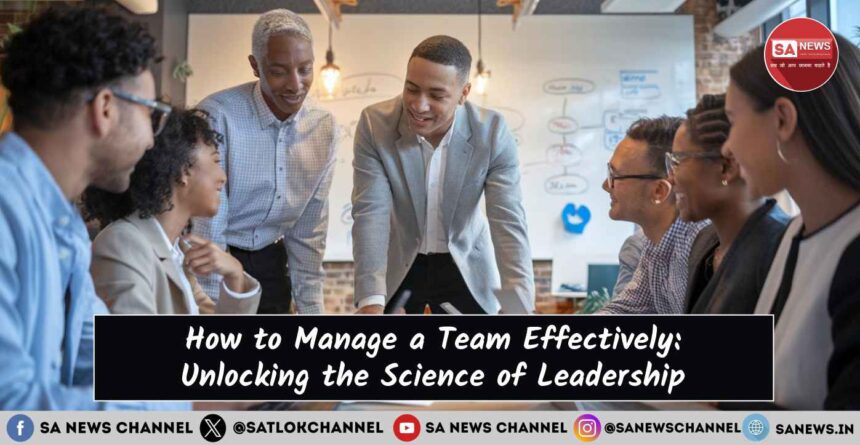“Employees do not leave jobs; they leave their Managers.”
This widely accepted statement underscores a critical issue in workplaces worldwide: ineffective team management. Team management is not just about allocating tasks; it involves fostering collaboration, nurturing growth, and driving results. Mismanaging a team doesn’t just hinder productivity but also fuels dissatisfaction, increases attrition, and impacts organizational growth.
- Core Principles of Team Leadership
- Crafting Clear Goals
- Strengthening Communication
- Nurturing a Positive Team Environment
- Addressing and Resolving Conflict
- Delegating Tasks Effectively
- Harnessing Technology in Leadership
- The Price of Ineffective Team Leadership
- Evaluating the Success of Team Leadership
- Building Emotional Intelligence (EQ) in Leadership
- Case Study: Reviving a Struggling Sales Team
- Managing Virtual Teams: Unique Challenges and Strategies
- Navigating Resistance to Change
- The Journey of Leadership Growth
- A Continuous Journey of Leadership Growth
- The True Essence of Leadership: A Path to Spiritual Enlightenment
This blog explores how to manage a team effectively, breaking down concepts with research-based insights, practical frameworks, and actionable tips. It’s written in an accessible tone, focusing on tangible steps anyone can implement.
Core Principles of Team Leadership
Successful leadership requires balancing three essential components: individuals, systems, and objectives. Without harmony among these components, achieving long-term success becomes challenging.
1. Recognizing Team Dynamics
Every team is a blend of distinct personalities, skills, and motivations. Understanding these dynamics is the first step toward effective management.
| Aspect | Impact on Team Dynamics | Example |
| Diversity | Enhances innovation but may cause friction if unmanaged. | Multidisciplinary groups brainstorming solutions. |
| Communication | Builds trust and clarity, preventing misunderstandings. | Conflicting priorities due to vague instructions. |
| Role Definition | Minimizes overlap and conflict. | Clear role assignments streamlining projects. |
2. Traits of a Successful Leader
According to studies published in Harvard Business Review, effective leaders exhibit seven key traits that enable them to guide teams efficiently:
– Empathy: Developing meaningful connections with team members.
– Decision-making: Blending data analysis with intuition.
– Conflict management: Resolving disputes constructively.
– Flexibility: Adapting seamlessly to changes.
– Communication: Ensuring messages are understood.
– Delegation: Assigning responsibilities strategically.
– Inspiration: Motivating others to excel.
Quick Tip:
Utilize tools such as the DISC Personality Profile or MBTI assessments to better understand team members’ preferences and working styles. Tailoring your approach can significantly enhance results.
Crafting Clear Goals
One of the primary tasks of a manager is to ensure that the team works toward common goals. Effective goal setting involves more than just defining objectives—it’s about aligning them with the organization’s vision and the team’s capacities.
1. The SMART Approach
The SMART goals framework ensures objectives are clear and attainable:
| Criteria | Explanation | Example |
| Specific | Precise, well-defined goals. | “Boost monthly sales.” |
| Measurable | Quantifiable indicators to gauge success. | “Increase by 15% in six months.” |
| Achievable | Realistic within the team’s resources. | “Using improved outreach tactics.” |
| Relevant | Tied to broader organizational priorities. | “Contributing to market expansion.” |
| Time-bound | Set deadlines to maintain focus. | “Achieve this by Q2 2024.” |
2. Bridging Individual and Team Aspirations
Research by Gallup reveals that only 41% of employees see alignment between their roles and company goals.
Strengthening Communication
Effective communication underpins successful team leadership. It lays the groundwork for trust, understanding, and teamwork.
1. Modes of Communication
Different scenarios require distinct communication approaches:
| Type | Purpose | Example |
| One-on-One Meetings | Personal discussions for feedback and support. | Biweekly check-ins with individuals. |
| Team Huddles | Aligning the group on objectives and updates. | Weekly progress reviews. |
| Digital Platforms | Streamlined coordination and information flow. | Slack for quick updates. |
2. Enhancing Communication Practices
• Listen Actively: Acknowledge and value input from the team.
• Simplify Messages: Avoid unnecessary complexity.
• Establish Feedback Channels: Enable honest, two-way communication.
Nurturing a Positive Team Environment
A productive work culture is critical for employee satisfaction and sustained performance.
1. Essential Elements of Team Culture
• Psychological Safety: Team perform better when they feel heard and respected.
• Recognition: Acknowledging achievements publically can boost their motivation.
• Diversity and Inclusion: Ensuring everyone feels valued, regardless of background.
2. Practical Culture-Building Steps
1. Define Core Values: Clearly communicate the team’s guiding principles.
2. Celebrate Successes: Highlight both minor milestones and major accomplishments.
3. Encourage Team Bonding: Activities like team lunches or retreats build camaraderie.
Addressing and Resolving Conflict
Conflict, if unmanaged, can derail team productivity. However, when handled well, it can lead to growth and innovation.
1. Common Workplace Conflicts
| Type | Nature | Resolution Strategy |
| Task-oriented | Disagreements over methods or goals. | Clarify objectives and align efforts. |
| Interpersonal | Personality clashes or differing work styles. | Mediate open and honest dialogue. |
| Process-related | Friction due to inefficient systems. | Revamp workflows collaboratively. |
2. The Conflict Resolution Framework
1. Identify the Problem: Address issues early.
2. Explore Perspectives: Listen to all sides impartially.
3. Seek Common Ground: Focus on mutual goals.
4. Implement Solutions: Take clear, actionable steps.
■ Also Read: Seventh Session of International Solar Alliance Assembly: A Step Towards a Sustainable Future
Delegating Tasks Effectively
Delegation is about enabling others while optimizing a leader’s focus on strategic priorities.
1. Obstacles to Delegation
Leaders often hesitate due to:
– Control Concerns: Fear of losing grip on standards.
– Perfectionism: The belief that “it’s quicker to handle myself.”
– Trust Deficits: Doubts about team competence.
2. Steps for Successful Delegation
1. Assess Fit: Assign tasks based on team members’ strengths.
2. Clarify Expectations: Specify goals, deadlines, and deliverables.
3. Equip the Team: Provide necessary tools and training.
4. Monitor Progress Discreetly: Offer guidance without micromanaging.
Harnessing Technology in Leadership
Modern tools can transform team management, making processes more streamlined and efficient.
1. Useful Management Tools
| Category | Functionality | Example |
| Task Management | Monitoring and coordinating activities. | Trello, Monday.com. |
| Communication | Facilitating real-time updates and dialogue. | Microsoft Teams, Zoom. |
| Performance Metrics | Tracking goals and achievements. | BambooHR, 15Five. |
2. Advantages of Using Technology
• Improved Transparency: Real-time updates for all stakeholders.
• Increased Productivity: Automating repetitive tasks.
• Data-Driven Decisions: Utilizing analytics for better planning.
The Price of Ineffective Team Leadership
The consequences of inadequate management are significant, highlighting the necessity of mastering this critical skill. According to Gallup, poor leadership can cost U.S. businesses up to $550 billion annually, stemming from disengaged employees and reduced productivity. Below is an exploration of the cascading effects of poor team leadership:
1. Consequences for Employee Engagement
• Exhaustion: Employees subjected to micromanagement or insufficient support are prone to burnout.
• High Turnover: Leadership dissatisfaction is a primary driver of employee attrition.
• Reduced Motivation: Unclear expectations or lack of appreciation can discourage even the most dedicated team members.
2. Organizational Challenges
| Outcome | Explanation | Illustration |
| Delayed Deliveries | Ineffective coordination slows down project timelines. | Missing a product launch deadline. |
| Stifled Creativity | Teams in discord avoid taking innovative risks. | Fewer groundbreaking ideas in R&D. |
| Increased Expenses | Recruitment costs rise due to frequent resignations. | Replacing a skilled worker costs 50–60% of their annual salary. |
Evaluating the Success of Team Leadership
Assessing leadership quality requires the use of measurable indicators. Key performance metrics offer actionable insights for improvement.
1. Employee Engagement Indicators
• Employee Net Promoter Score (eNPS): Assesses the likelihood of employees recommending the workplace to others.
• Regular Feedback Surveys: Frequent, concise surveys measure morale and workplace satisfaction.
• Absenteeism Trends: High absence rates can signal disengagement or dissatisfaction.
2. Performance Indicators
| Indicator | Objective | Measurement Method |
| Goal Achievement Rate | Gauges how effectively objectives are met. | Percentage of goals successfully completed. |
| Project Completion Speed | Measures how quickly tasks are executed. | Time taken from project initiation to finish. |
| Work Quality Standards | Evaluates the caliber of output. | Stakeholder or client feedback. |
Building Emotional Intelligence (EQ) in Leadership
Technical knowledge alone doesn’t suffice for effective management; emotional intelligence is equally essential. Daniel Goleman outlines five pillars of emotional intelligence crucial for leadership success:
1. Self-awareness: Understanding personal emotions and their influence on others.
2. Self-control: Managing impulses and adapting to changing scenarios.
3. Intrinsic Motivation: Staying committed to personal and organizational goals.
4. Empathy: Recognizing and valuing the emotions of team members.
5. Interpersonal Skills: Fostering relationships and resolving conflicts constructively.
Practical Steps to Enhance EQ
• Daily Reflection: Record and analyze emotional responses to various interactions.
• Perspective-Taking Exercises: Actively consider team members’ viewpoints.
• Conflict Simulation: Role-play scenarios to practice conflict resolution.
Case Study: Reviving a Struggling Sales Team
Situation
A sales team faced low morale, confusion over responsibilities, and frequent interpersonal conflicts, leading to underperformance.
Interventions
1. Role Clarity: Clearly defined responsibilities minimized overlaps.
2. Recognition Initiatives: Monthly rewards for exceptional performance boosted motivation.
3. Regular Feedback Sessions: Weekly open forums improved communication and transparency.
Results
• Productivity improved by 25% within three months.
• Employee satisfaction rose by 40%.
• Revenue increased by 15%.
This example illustrates the significant impact of deliberate, empathetic team leadership.
Managing Virtual Teams: Unique Challenges and Strategies
As remote work becomes the norm, effective leadership in a digital environment requires overcoming distinct hurdles.
Challenges
• Communication Breakdowns: Absence of in-person interaction can lead to misunderstandings.
• Social Isolation: Remote employees often feel disconnected from their peers.
• Progress Monitoring: Tracking productivity remotely can be difficult for managers.
Effective Strategies
| Approach | Explanation | Application Example |
| Daily Updates | Short meetings to align tasks and priorities. | Morning virtual check-ins via video calls. |
| Flexible Scheduling | Allow employees autonomy in managing their time. | Combining core hours with flexible timings. |
| Virtual Team Activities | Build camaraderie through informal online gatherings. | Hosting trivia games or virtual coffee chats. |
Navigating Resistance to Change
Implementing new policies or methods often meets with pushback, which can derail progress. Addressing resistance early is crucial for success.
Why Teams Resist Change
• Fear of Uncertainty: New processes may cause anxiety.
• Lack of Trust: Employees may doubt leadership’s competence or intentions.
• Loss of Autonomy: Changes can make employees feel less in control of their work.
Strategies to Overcome Resistance
1. Transparent Communication: Explain the purpose and advantages of changes clearly.
2. Inclusive Decision-Making: Involve employees in planning stages to secure buy-in.
3. Celebrate Milestones: Recognize small achievements to reinforce confidence in the transition.
The Journey of Leadership Growth
Leadership is not static; it evolves as managers refine their skills and adapt to organizational changes.
Self-Improvement Practices
• Regularly reassess leadership styles and seek feedback for adjustments.
• Identify development areas through peer evaluations or mentorship.
Lifelong Learning Opportunities
• Workshops and Conferences: Stay updated with contemporary management techniques.
• Books and Podcasts: Gain insights from renowned thinkers like Simon Sinek or Brené Brown.
• Professional Certifications: Programs like PMP enhance credibility and competence.
A Continuous Journey of Leadership Growth
Effective leadership is an ongoing process of learning, adapting, and improving. Every team is unique, requiring customized strategies to unlock its potential. By emphasizing understanding, communication, alignment, and constructive feedback, leaders can foster a thriving work environment.
The path to successful leadership demands patience, self-awareness, and dedication to growth—not only for the team but also for the leader themselves.
The True Essence of Leadership: A Path to Spiritual Enlightenment
While effective team management fosters professional success, the true purpose of life lies beyond career achievements. True leadership, both in work and life, emerges from wisdom, self-awareness, and devotion to the Supreme God. By aligning with spiritual truths, we gain clarity about our life’s mission.
Books like Gyan Ganga and Way of Living by Saint Rampal Ji Maharaj offer profound guidance on the true methods of worship and ethical living, helping us navigate both worldly and spiritual leadership. Discover your divine purpose, and let spiritual wisdom lead you toward fulfillment and peace.









